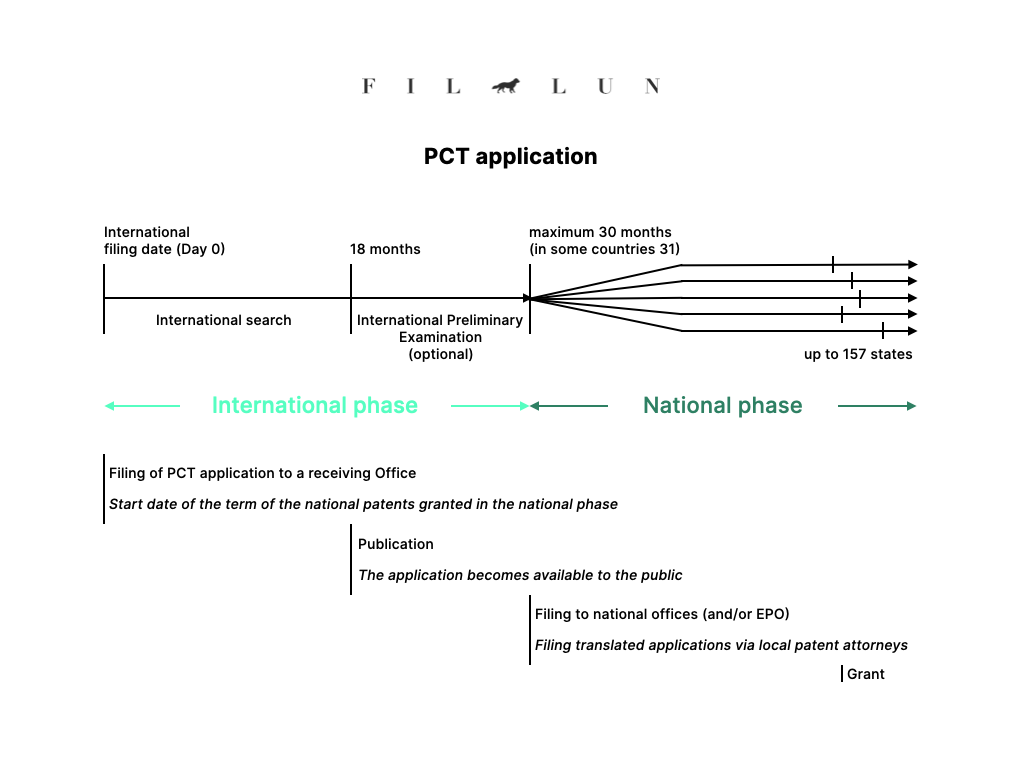Where to file?
Territorial right
Patent applications have to be filed at patent offices. Each patent office covers a territory where the patent granted by said patent office will be valid. A patent granted by the German Patent Office will be valid in Germany, a patent granted by the United States Patent and Trademark Office (USPTO) will be valid in the United States. That is the territory where the exclusive right will apply, i.e. that is where you have the right to prevent third parties from commercially using your invention without authorisation.
There is no such thing as a worldwide or international patent. If someone wants his invention to be protected in different states, he must hold rights in each of those states. For example, producing an invention protected by a German patent in France does not constitute infringement.
When it comes to the European Patent Office (EPO), the case is a bit different. You can apply for a European patent at the EPO with a single filing, and eventually obtain patent protection in 39 countries, called Contracting States. (And even more countries counting the validation and extension possibilities.) In the European patent procedure you have to choose the countries after grant where you would like to validate and maintain the patent. Thus, the European patent becomes a bundle of national patents upon grant. (You can read more about the European patenting procedure below and in a separate article (“European patent application timeline with expected costs”) as well.
Filing strategies
Choosing a route for your patent application will depend on your IP strategy, more specifically on your invention, business plan, available funds, intended market and the likeliest sources of infringing products. Preferably, you will discuss these with your patent attorney, and you will create a strategy together before filing. Your strategy will include how many patent applications to file and where you will file first, furthermore, whether you will use the priority year.
In a nutshell, you can choose between filing:
direct national application(s),
If you are seeking protection in one particular country only or only in a few countries, it may be best to apply direct for a national patent to each of the national offices.
European patent (and other regional applications such as Eurasian),
There are a few regional patent applications, one of which is the European patent. Choosing this option is advisable if you need protection in at least 2-3 countries from a certain region.
PCT application.
PCT is a widely used route, since it has several advantages for applicants. PCT is helpful if you need more time, and/or if you are not sure about where you will want to file. PCT covers more than 155 countries, including many non-European countries. (See more information below.)
You can also combine these routes if you wish, and file a direct US, a European and a PCT application at the same time.
When filing more applications, please remember the definition of priority: from the first filing date you have maximum 12 months to file any patent applications for the same invention.
A few examples
A popular strategy is to file a patent application in your home country and then a PCT application a few months - maximum 12 months - later, claiming the priority of your first application. However, if there is an important territory for your business, you should file there as soon as possible, since the protection only starts with the filing date.
Let's see an example. In this example, as a first filing you filed a US provisional application because of your investors based in the US. Let's also assume that Germany is a very important territory for your business, where you have business partners who you plan to sell licensing rights at the earliest (in order to generate profits as soon as possible). You can obtain a patent that is valid in Germany different ways:
Filing a national patent application at the German Patent Office (DPMA)
Filing a European patent application
Filing a European patent application and then requesting Unitary effect
Filing a PCT application and then designating the German Patent Office in the national phase
Filing a PCT application and then designating the European Patent Office in the national phase
Filing a PCT application and then designating the European Patent Office in the national phase and then requesting Unitary effect
All of these routes can end with a valid patent in Germany. However, regardless of which route you choose, you have to file the application within 12 months of filing the US provisional. Furthermore, in most cases, your patent will only be valid in Germany if you pay annuity fees to the German Patent Office (DPMA) (except for the Unitary Patent). (If you go through the European route, you will first pay the annuity fees to the European patent office, and then, after grant, to the DPMA.)
In this example you started with a US provisional application as a first filing. Although, when claiming priority, you can wait up to 12 months before filing your second application in order to obtain a German patent (by any of the above alternative routes), you should not. Your patent right in Germany will only start when you file an application through any of the four routes above (German/European/PCT).
PCT application (also called "international patent application")
By filing an international patent application under the PCT, applicants can simultaneously seek protection for an invention in a large number of countries (See the full list of the member states here.)
So, instead of having to file your application in X countries in X languages, using X patent firms and paying the fees of X patent offices, you can file a single application and then decide about the countries at a later stage.
With a single filing (in one language) and a one-time payment you are provided with a date of filing, and the possibility to start national phase in any of the PCT member states 30 months (2.5 years) later. Thus, PCT helps you delay the decision about which countries to choose, delay the national or regional procedures and also delay the respective fees and translation costs.
To summarize, PCT saves you both time and money and lets you focus on your invention in the initial period.
PCT is very useful, if:
you need a patent in at least 2-3 member states of the PCT (almost all countries are members, but check here),
you need more time to decide about where you need patent protection,
you need more time to get funding,
you need more time to explore the commerciality of the invention and time to focus on building your business, or
in the first 2.5 years, you would rather spend money on your business instead of on patenting fees.
PCT timeline in a nutshell:
A PCT application has two phases; an international phase in which patent protection is pending under a single patent application, and a national phase which follows the international phase. The application only continues in the national stage if the applicant chooses at least one member state and enters the national phase by filing the necessary documents at the patent offices of the chosen countries. The final deadline for entering national phase is 30/31 months - depending on the patent office - from the first filing date (priority day), but they can be started earlier as well. Once the national stage started, the application is handled and examined according to the usual treatment of patent applications in the countries chosen, and all of the local time limits, laws, rules, and procedures must be observed. Thus, the decision on granting patents is made exclusively by the national or regional Offices in the national phase.
European route
When seeking patent protection in one or more EPO Contracting states, you can choose either to file at the national patent offices and start the national procedures in each country, or to take the European route, which confers protection in all the European Contracting states in a single procedure.
The single procedure ends with the grant. After grant, the European patent divides into a plurality of national patents after grant. After grant, you will be required to pay the annuity fees directly with the national patent offices.
If you decide that you need a European patent, you have a further choice between the direct European route and the Euro-PCT route. (Euro-PCT means designating European Patent Office (EPO) in the national phase of a pending PCT application.)
TIP: In summary, you are probably better off filing a European patent application, if you would like to obtain patent protection in at least three European countries, or if you are not sure yet which countries you will have (successful) business in.
According to the EPO's website, it currently costs on average about EUR 6000 (official fees) to get through the European patenting process. It is difficult to say how many national applications (official fees) you could cover with this amount, maybe about four. However, managing one patent application with its deadlines is simpler than monitoring three or more separate national applications. Furthermore, the patent attorney fees would be much higher for separate patent applications.
You can check the timeline of the European patent application here: “European patent application timeline with expected costs”
Filing date
After you filed the necessary documents and if your documentation appears correct, your application is given a filing date - also known as a priority date. As mentioned above, from this date, you have 12 months to file a national, regional or PCT application for the same invention. The date of filing is a very important date for several reasons, since it is the date from which the term of the patent is calculated, and the filing date will represent the date at which the invention’s patentability (novelty, inventive step, etc.) is assessed.
Actually, to get a filing date, only a very few requirements have to be fulfilled. To obtain a filing date, you do not even have to pay the filing fee. So, if you only need a filing date for the purpose of claiming priority or for investors, it is quite simple to get one. However, if you plan to keep the application alive and request examination, you should indeed file a full application, because adding new information to the application is not possible.
After filing there is a formalities examination to ensure that your documentation is correct and complete.
If you do not understand a term, check out the IP dictionary here.
Author: Zsofia Pintz
Published: August 2020
Updated: July 2023

Do you have any questions?
Feel free to contact us if you have any questions, suggestions or to arrange a consultation.
Related articles
European patent application
timeline with costs
The European patent grant procedure lasts about two to five years from when the application is filed. In this rather long article you will find all the steps, deadlines and fees that occur during the process.
PCT (international patent
application) timeline
Are you interested to learn more about the most popular patenting process that covers more than 155 countries? Read the article to find out the steps, advantages and disadvantages of the PCT.
What happens after filing a European patent application?
What happens once the patent application is filed at a patent office? Can you just sit and wait for the grant or do you have responsibilities? Let's take a look.






